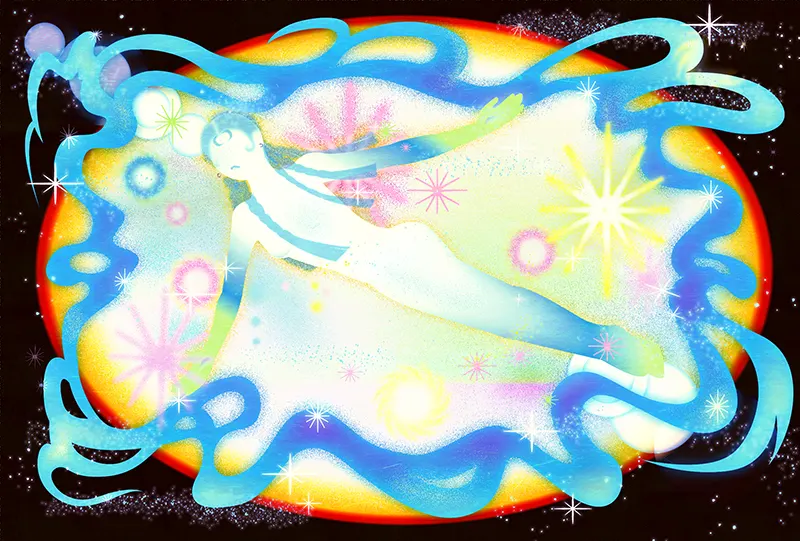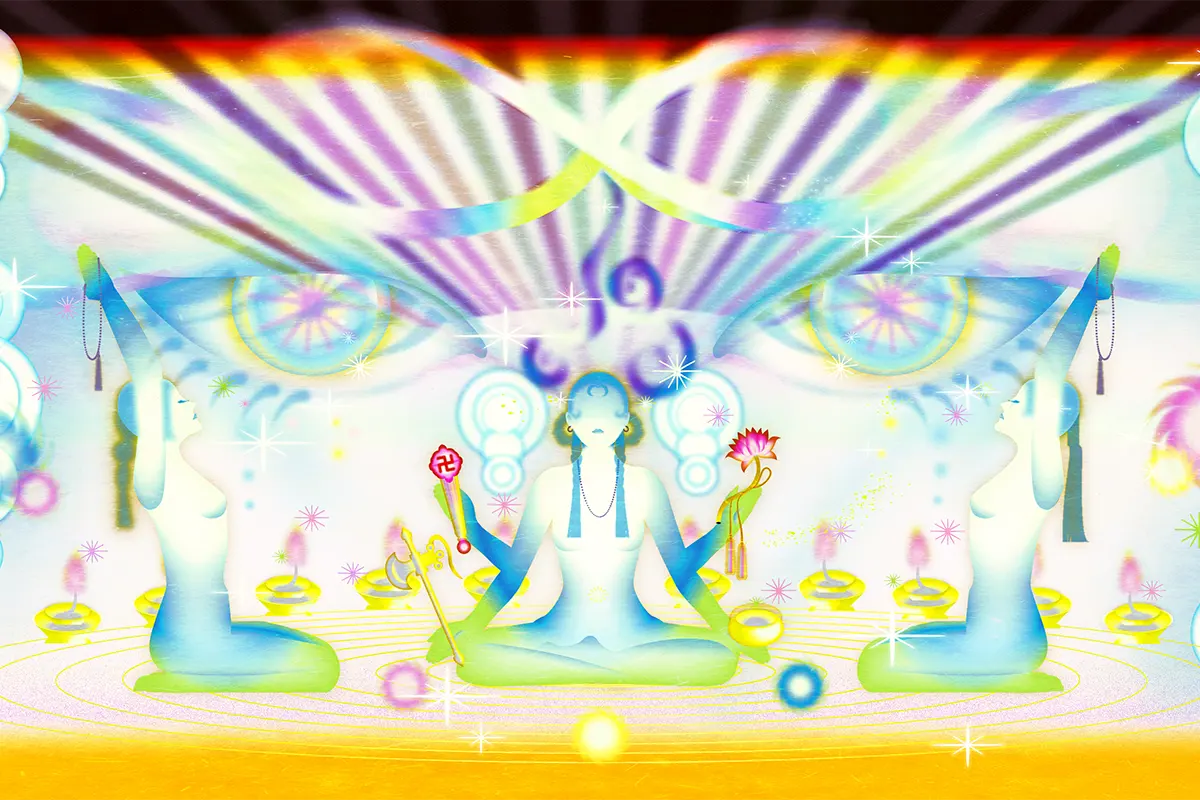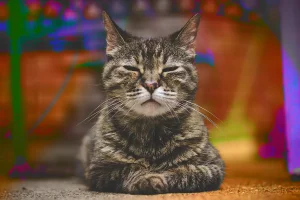I step into a sunlit room and see trappings of my culture all around me: Lord Ganesha on the bookshelf, sounds of a harmonium playing softly in the background, a woman with a mala wrapped around her wrist raising her hands in a pranam. We will start our mushroom journey with an aphorism from Ram Dass and a practice of what, in the West, has become known as “mindfulness meditation.” Neem Karoli Baba—the guru who taught and bestowed the name of Ram Dass on Richard Alpert (the psychologist who launched Harvard University’s Psilocybin Project, alongside Timothy Leary) is not acknowledged. The roots of the Buddhist meditation practice have been erased.
These oversights are not limited to my journey or unique to Asian culture, as evidenced by the paucity of recognition and resources flowing back to communities that have, for millennia, stewarded healing and sacramental substances that are now being used by the “psychedelic drugs market,” projected to reach nearly $11 billion USD by 2027, according to a report put out by Research and Markets. Nor are they limited to psychedelic ceremonies. In Who is Wellness For?, Fariha Róisín, a Muslim author of Bangladeshi descent, writes of an “urge for white people to commodify, to steal through a decontextualization of where certain practices come from.”
This decontextualization may be inadvertent. But the erasure and decoupling of the origins of Asian faith traditions and philosophies contributes to my gnawing discomfort. The elephant-headed statue that adorns the illuminated space is deeply rooted to my identity as a Hindu, not simply décor. The Sikh mantra on the journey soundtrack is soothing to those who can’t understand the Gurmukhi words or recognize the mispronunciations. But, to me, the words are not background music; they are sacred. I want them to transport me to my grandmother’s prayer room, but the Western chanter’s egregious mispronunciations serve as a reminder that the most sacred parts of me have been taken and distorted.
READ: Why the “Psychedelic Renaissance” is just Colonialism by Another Name

While it may seem benign to an outsider, the pain of cultural appropriation is tangible and visceral—especially when one is under the influence of psychedelics that, as Czech psychiatrist and LSD researcher Stan Grof described, are “non-specific amplifiers.” In their study Challenging Definitions of Psychological Trauma: Connecting Racial Microaggressions and Traumatic Stress, Kevin Nadal and his colleagues explain that microaggressions “may activate or exacerbate typical PTSD symptoms—including but not limited to hypervigilance, anxiety, avoidant behavior, and intrusive thoughts.” That’s why it is imperative that therapists, guides, and sitters recognize that the traumas that can surface in psychedelic experiences can be the result of overt and systemic acts of racism, xenophobia, and ethnocentrism as well as smaller (but no less impactful) microaggressions.
A 2021 study of people who identified as Black, Asian, Latinx, or Native/Indigenous heritage, led by University of Ottawa psychology researcher Monnica T. Williams, found that “psychedelics can ameliorate symptoms of racial trauma.” But Williams, who specializes in mental health disparities, speaks to the fact that in order for psychedelic experiences to most effectively heal these groups of people (and reduce the potential for further harm), we need to honor their existing lineages and traditions. It’s part of what American psychologist and pioneer of LSD-assisted psychotherapy Betty Eisner referred to as the “matrix,” what she defined as “the environment from which an individual comes, in which the individual lives during the time of the sessions, and to which the individual returns.”
For Asians, the matrix is vast. We have roots in the largest and most diverse continent in the world—home to over 2,300 languages; the birthplace of the world’s major religions; a rich tapestry of arts, science, and culture; and the center of origin for some of the world’s most revered foods and established healing traditions. In the United States—where Asians are the fastest growing ethnoracial group—we represent more than 40 different ethnicities, 100 distinct languages, and every dominant faith tradition. About 60 percent of us (including me) were born outside of the country, and carry the intergenerational impacts of tragedies including the Korean War (the third most devastating war of the 20th century behind World Wars I and II); Partition (one of the largest and most violent political migrations in human history); the Vietnam War; wars in Afghanistan and Iraq; genocides in East Timor, Cambodia, and Myanmar; famine; and the climate crisis.
READ: The Function of Awe
Asian trauma has also occurred in the West through forced migration, internment, lynching, and assault—as well as experiences of othering where we are disallowed from seeing ourselves as fully American (evidenced by the ubiquitous question, “Where are you really from?”). It also exists in the oppressive model minority stereotype that not only erases who we are and how we have struggled and survived, but positions us against other minoritized groups despite our shared oppressors and oppressions. This is what we carry into our journeys, what we seek to heal, and what we eventually need to integrate.
How to Grow Shrooms Bundle
Take Both of Our Courses and Save $90!
“All of the injustices that can be committed against humans, we Asians have experienced,” says Terence Ching, a postdoctoral associate at the Yale OCD Research Clinic, who co-leads the development and conduct of psilocybin clinical trials for OCD. “Yet, somehow, we get left out. That is the trauma of invisibility.”
Despite this, Asian Americans are three times less likely than their white counterparts to seek help for mental health challenges and the group least likely to seek mental health support overall, according to the National Survey on Drug Use and Health. In 2020, just 20 percent of Asian Americans (in this data, tallied with Pacific Islanders) with mental health issues sought treatment. This is the result of deeply-ingrained notions about face, a term used by sociologists to describe how a person perceives who they are in social spaces and the images they try to cultivate in order to be favorably regarded. “This code of privacy,” psychologist Jenny Wang writes in Permission to Come Home, “is one of the reasons we might be hesitant to…reach out for professional mental health help, because the act of being vulnerable and honest about our emotions and struggles can be seen as exposing family secrets and bringing shame upon ourselves and our families.”
This is exacerbated by societal perceptions around drug use that are deeply rooted in colonization. In India, for example, British imperialists had some knowledge of cannabis usage in the early 1800s. The complex plant, which originated in Asia, is intimately connected to the Hindu God Shiva, and is used both medicinally and recreationally. It was not considered “dangerous,” however, until its usage seemed to threaten the rule of the British East India Company. By 1873, James H. Mills explains in Madness, Cannabis, and Colonialism, cannabis was linked to a range of mental and social disorders. By 1880, those fears worked their way into British medical journals including The Lancet.
I am intimately aware of these dual stigmas around drugs and mental health—and know how powerfully psychedelics have helped me get on top of my depression and anxiety. Yet Asians—along with other people of color—are woefully underrepresented in research. A review of clinical trials published in 2018 in BMC Psychiatry found only 1.8 percent of study participants were of Asian origin (during a time when Asians comprised roughly 7 percent of the US population). This absence creates what authors of a 2021 study on Ethnoracial Health Disparities and the Ethnopsychopharmacology of Psychedelic-Assisted Psychotherapies describe as “a vacuum of data that is essential to identifying ethnoracial factors accounting for differences in, or negligibly affecting, pharmacological responses” to treatment.
This is why I founded the Asian Psychedelic Collective, a non-profit dedicated to forging belonging, support, and empowerment for Asians working in and with psychedelics. We achieve this through community gatherings where we can safely process our psychedelic experiences, educational offerings that are both attuned to our culture and highlight the history of entheogenic practices within Asian culture, and advocacy for greater Asian presence in clinical trials, practitioner trainings, and leadership positions within the psychedelic industry.
Psychedelics are not the solution for everyone, but they should be both available and accessible to all. And access requires consideration of the matrix. “The term I use,” says Ching, “is ‘culturally-attuned care,’ because in order to be sensitive to someone, you’ve really got to pay attention to them, and make the conscious effort to not let stereotypes get in the way of actually listening.” And when care is attuned, an even deeper level of healing is possible.
“Journeying and integrating with kindred, conscious Asian women have served as pivotal points in my path to healing and releasing,” says Yae-rin Kweon, a young Korean artist who has worked with psychedelics. “Particularly when most of what needs shedding is linked to generational and ancestral trauma, as well as the wounds of my lifetime from facing institutions and people who view me as a statistic, an asset, a sex object. I can’t say that I haven’t connected meaningfully with white folks, [but] I feel that there’s less resistance when engaging with beings who share my external identifiers. There’s less to explain, less lost in translation…establishing a feeling of safety comes more naturally. In a most vulnerable sense, I felt seen, heard, and held.”
This reporting was made possible with the support of the the Ferriss – UC Berkeley Psychedelic Journalism Fellowship

DoubleBlind is a trusted resource for news, evidence-based education, and reporting on psychedelics. We work with leading medical professionals, scientific researchers, journalists, mycologists, indigenous stewards, and cultural pioneers. Read about our editorial policy and fact-checking process here.

DoubleBlind Magazine does not encourage or condone any illegal activities, including but not limited to the use of illegal substances. We do not provide mental health, clinical, or medical services. We are not a substitute for medical, psychological, or psychiatric diagnosis, treatment, or advice. If you are in a crisis or if you or any other person may be in danger or experiencing a mental health emergency, immediately call 911 or your local emergency resources. If you are considering suicide, please call 988 to connect with the National Suicide Prevention Lifeline.




